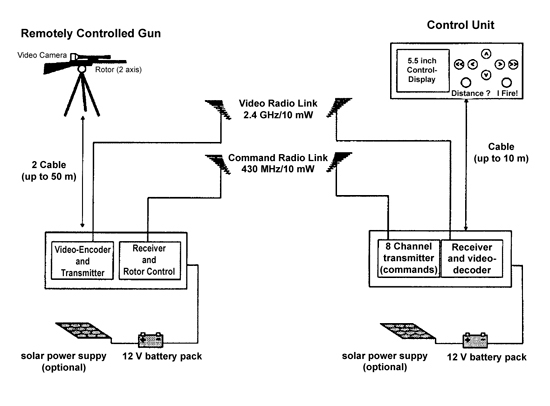A Video-Enabled, Radio-Controlled, Remote Telinjection System for Field Applications
Abstract
Though the market now supplies several safe and efficient remote drug delivery systems for immobilizing nondomestic animals in captive and free-ranging situations, the range and accuracy of available products is still limited. These limitations prevent the successful immobilization of some free-ranging wildlife by remote injection, as some animals can be difficult to approach. For example, within the framework of the Przewalski’s horse (Equus przewalskii) reintroduction to Mongolia (www.takhi.org) we are faced with immobilizing animals in a flat steppe habitat without adequate cover for an approach, and animals typically flee at distances in excess of 300 meters. In order to overcome this problem, we developed a remote gun that can be controlled from a distance (Figure 1), which, therefore, has greatly superior functional “range” than the actual range of the gun.
Figure 1

Radio-control setup for the remote gun (the second video link is not shown, for simplicity)
We mount a modified CO2-powered gun (Daninject JM™, Wildlife Pharmaceuticals, Fort Collins, CO) on a heavy-duty tripod (Gitzo Compact 5 VA™, Gitzo S.A., F-94044, Creteil, France) with a motorized video-head (PH 886™, B&H Photo, NY, NY). We use a bidirectional radio link for remote system control from a blind (average distance 300 meters). We fix a video camera (Conrad™, A-4600, Weis, Austria) at the ocular of the gun spotting-scope, which transmits the picture through a 2.4-GHz radio link to the control station. A receiver decodes the information and a 5.5-inch TFT display enables us to utilize the view field of the spotting scope. Our spotting scope has an integrated laser rangefinder (Swarovski LRS™, Swarovski Optic K.G, A-6067, Absam/T, Austria), which relays information on the distance of the chosen target from the gun. This is important in order to ensure that the selected pressure of the gun corresponds to the target distance. An eight-channel radio remote control is used to (1) control direction and inclination of the video-head (six channels: right and left with two speeds, up and down with one speed, (2) trigger the laser distance measurement, and (3) activate the pressure release mechanism (shot). The entire hardware (monitors, radio receivers and transmitters, switchbox) is mounted in two boxes: one close by the gun (distance up to 50 meters) and one at the control station. Both boxes are housed in waterproof cases (Pelicase® Water Safety Europe, D-13353 Berlin, Germany) and weighing approximately 5 kg, including batteries. The distance between gun and control station depends on the power output of the radio links and the antennas used. Presently we are restricted to a distance of several hundred meters as we are using licensed radio bands available to the public. In the future employing other frequencies can easily extend the control range. A second video camera providing a panoramic overview of the entire situation is installed behind the scope.
These modifications do not impair upon the accuracy of the original gun. Time delay due to image transmission is not appreciable to the naked eye. Training is initially of utmost importance to enhance eye-hand coordination.